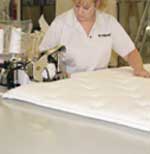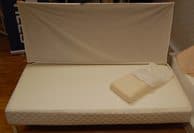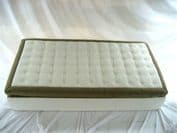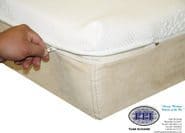At one time, mattress kit and quilt suppliers offered bedding producers a rather basic product mix—mattress kits containing quilted panels, a quilted border and a foundation cover; quilt rolls; and other presewn mattress components. Their business was largely regional, supplying smaller mattress makers who didn’t have the means to invest in quilting equipment and labor.
The ongoing decline in mom–and–pop manufacturers, the implementation of a federal open–flame mattress standard in 2007 and the recent recession all have taken a bite out of the kit, quilt and contract sewing business, suppliers told BedTimes.

Multiservice providers: Mattress kit and quilt suppliers like Quilting Inc. say mattress manufacturers of all sizes find benefits to using their services and products.
But these suppliers are finding new niches. In addition to still offering a catalog of standard kits, suppliers are acting as design experts, providers of ever–more complex custom sewing operations, sources for zippered covers and resources for FR guidance.
Today’s typical mattress kit requires minimal assembly, even as bed designs have become more ornate. It might include a bottom panel sewn to a tack–and–jump border with decorative ribbon applications and a top panel with an inner deck to hold micro–coils, specialty foams or even heating and cooling elements.
The popularity of the zippered cover has been a boon to many suppliers, since mattress manufacturers—regardless of size—are not generally equipped to fabricate them on–site. Mattress manufacturers’ interest in offering sleep accessories such as pillows and toppers for retail display and consumer purchase has opened another area of growth for kit and quilt suppliers.

Labor–intensive: More ornate mattress covers can take up to an hour to construct, part of the reason mattress makers turn to kit and quilt suppliers, according to VyMaC Corp.

Meeting design demands: Ideal Quilting Ltd. offers Kultur software, which allows customers to create up to 14,000 different looks by changing various design elements.
Who turns to outsourced sewing?
Who buys mattress kits, covers and sewn components? Everyone from small Internet–based specialty sleep retailers to the family–owned independents to the national mattress brands, suppliers say. Kit and quilt companies handle a producer’s overflow sewing operations, preventing them from having to add a second or third shift or they may supply all the covers for a bedding major’s entire high–end line.
“For the majors, we can work with economy and speed and sew it faster than they would,” says Adam Lava, sales manager of A. Lava & Son Co. in Chicago, which offers a full range of kits, quilts, zippered covers and custom sewing services. “We’re a one–stop shop from concept to commercialization. Small players can produce looks similar to the national brands by outsourcing to us.”

Zippy sales: Sunds Velour A/S says about half of its current production is zippered covers, which the company offers for mattresses and accessories.
“Smaller mattress manufacturers can offer a higher end product than they have the capability to produce and they don’t have to hold large inventories of components or finished goods. Plus, they get to utilize the buying power of a large operation,” says Dave Pritchett, operations manager at Quilting Inc. in Plain City, Ohio. The company specializes in custom quilted components and mattress kits.
“Today, most mattress manufacturers are assemblers of beds—not cut–and–sew operations,” Lava says. “Maybe they were back when the industry was less automated and there was more measuring and cutting, but not anymore. And manufacturers aren’t buying a ton of covers from overseas because they need quick turnaround. ‘Just–in–time’ is an industry mantra. I get orders on Monday and ship on Friday.”

Pretty as a picture: Supreme Quilting says it tries to ‘stay ahead of the curve design–wise’ with European styling and ‘picture frame’ panels.
Demand for high-design
Suppliers in the segment say their growing design capabilities also benefit mattress manufacturers.
“Some covers can take over an hour apiece to construct,” says Dave Young, chief executive officer of mattress sewing contractor VyMaC Corp. in Fort Atkinson, Wis. “We’re doing some really fascinating stuff with thick, deluxe panels and intricate tack–and–jump borders with accessory add–ons. We’re asked to insert encased coils or specialty foams and gels and sew them into the cover. Instead of running the same fluffy rectangles through your plant year after year, we offer an opportunity to bring in high design.”
VyMaC produces a full range of sewn components, from traditional kits to zipper kits to individual components and sleep accessories covers.

New opportunities: Zipper kits enable startup mattress companies, says PPI’s Todd Schmidt: ‘You can create your own foam build–up, buy the covers and you’re in business.’
“It’s important for us to stay ahead of the curve design–wise. We’ve moved toward more European styling such as the ‘picture frame’ top panel and we need to be able to offer design advice to customers. They depend on us to be able to change on the go, because they can’t,” says Steven Finkelstein, president of Supreme Quilting in Etobicoke, Ontario, a supplier of kits, quilts, zippered covers and custom sewing.
Ideal Quilting Ltd. has added 15 new designs to its catalog and recently launched its Kultur design software, which allows customers to create as many as 14,000 different looks by changing borders, quilts, colors, handles and other mattress accents.
“We see ourselves as more than a supplier—as a design assistant, R&D resource and development partner to manufacturers,” says Paul Sharon, vice president of sales and product development at the North York, Ontario–based company. Ideal Quilting specializes in zipper kits and custom work.

Specialty sleep: ‘People don’t want their expensive specialty sleep mattress to look like an innerspring bed,’ says Adam Lava, whose company, A. Lava & Son Co., constructed this cover for the Embody by Sealy line.
Rise of the zippered cover
Zippered covers in stretchy double–knit for use on specialty foam beds are one of the biggest areas of growth in the kit and quilt business. And suppliers expect the zippered cover business to continue growing as interest in specialty sleep expands.
“Obviously there has been a major focus on reducing costs during the last few years,” says Steffen Rømer, vice president of sales at knit ticking and zipper cover supplier Sunds Velour A/S in Sunds, Denmark. “In some cases, this has resulted in the outsourcing of zipper cover production. Half our production ships out in the form of zipper covers today.”
Tempur–Pedic launched the simple, iconic style with its original wrapped, zippered cover, but the look has evolved over time into something much more decorative. Now there are waterfall edges, picture frame panels, cording, suede borders, highly textural super–stretch tickings with ornate stitch patterns, contrasting yarn colors and more.
“Sewing zippered covers is something many in the mattress manufacturing industry are not prepared to tool up for,” Sharon says. “But we are. And now we’re adding specialty cuttings, angled corners and bands and grips with different colored threads and top stitching.”
“Specialty sleep is more fashion and color conscious,” Young says. “We’re doing different looks and bringing in upholstery ticks and jumbo patterns with 24–inch repeats.”
“The important thing to remember is that people don’t want their expensive specialty sleep mattress to look like an innerspring bed,” Lava says. “They’re using nontraditional fabrics, upholstery fabrics—not just damasks or double knits. With our specialized sewing equipment, we can get as creative as we want. Just like with any other piece of furniture, you can sew in piping, cording, ribbon. You can really dress up the bed. It’s the reason people like us have found a niche with zipper covers.”
Other recent zipper trends include the use of multiple fabrics in a single cover, as well as increased production of pillow and topper covers because many mattress manufacturers have added those items to their product lines, Rømer says.
“Some of our ‘zipper’ covers don’t actually have zippers because manufacturers don’t want the beds to be opened up,” explains Todd Schmidt, president of PPI, a cover supplier based in Riverside, Calif. “These types of kits will usually be taped on the bottom with a tape edge. The availability of zipper kits is also enabling a lot of startup mattress companies. You can create your own foam build–up, buy the covers and you’re in business.”
“All you need is a foam core and a table,” adds Finkelstein.
Trending now
Expect to start seeing zipper covers on innerspring mattresses, too. In addition to adding visual appeal and trendy styling, zipper covers can simplify mattress production and reduce labor costs, suppliers say.
“Encased coil units are an untapped market for zipper covers,” Lava says. “And some mattress manufacturers are looking at putting them on foam–encased traditional innerspring beds. It’s something to look at.”
“My belief is you’ll be seeing more and more knock–down mattress formats where the kits are very elaborate and exotically sewn and the customer just adds the core innerspring,” Young says.
“The biggest trend in kits and covers is people are getting away from quilting by having lots of stretch and recovery in the fabric,” Schmidt says. “We’re the quiet rebels—I hate quilting. It hides the feel of the bed and it costs you more money to manufacture. You can get the quilted look without the quilting from some of the good textile companies.”
Other trends in mattress kits and covers include the use of natural fabrics and fills—mainly cotton and wool. Quilting Inc. offers zippered covers in natural cotton with a wool quilt. The covers typically are used on all–latex beds.
Most kit and quilt suppliers also are offering matching pillow covers and sometimes topper covers for use in retail displays or for sale directly to the consumer.
“We’re seeing more interest in topper and pillow covers, Lava says. “People are taking visco–elastic, sizing it down to a 2– to 3–inch height for a foam topper and adding styling to it with zippers, trim cording, piping and different fabrics. It’s an after–market product mostly, but a growing segment.”
Suppliers become partners in FR compliance
Since the implementation of the federal open–flame standard for mattresses in July 2007, mattress kit and quilt suppliers have found themselves taking on a new role—as a partner in helping mattress manufacturers comply with the requirements of 16 CFR Part 1633.
Suppliers are designing mattress kits and components that contribute to FR compliance, conducting prototype burns, developing FR supplier networks and more.
“We’ve done hundreds and hundreds of burns with our customers and have developed certain products that help our customers be compliant,” says Adam Lava, sales manager of mattress kit, quilt and sewing contractor A. Lava & Son Co. in Chicago.
“Our company actually pays for FR testing. We have an arrangement with a testing facility,” says Dave Pritchett, operations manager at Quilting Inc. in Plain City, Ohio. “We will provide a workbook with forms that tell customers how to follow the guidelines and what you need to do in your facility to pass (an open–flame burn test). The customer only has to build a product and do a confirmation burn.”
“We tell manufacturers what they can and can’t do with our kits and how our qualified prototype worked. We can suggest FR vendors to our customers and there are also some inherent tickings we work with that are doing a good job with FR,” says Dave Young, chief executive officer of mattress sewing contractor VyMaC Corp. in Fort Atkinson, Wis.
Steven Finkelstein, president of kit, quilt and sewing supplier Supreme Quilting in Etobicoke, Ontario, says that with new FR regulations, much of his company’s U.S. business “has evolved more to a finished product.”
“And we handle it all, so that all a customer has to do is know what the build of the mattress is and we will give them a prototype. By law, all they need to do is one confirmation burn,” he says.
FR compliance is not static. Each significant innovation and change in mattress design can necessitate changes in how FR compliance is achieved. For instance, with the increasingly popular zippered covers, the zipper area requires special design considerations to pass an open–flame burn test.
“With FR–inherent tickings, zipper placement can get complicated,” says Todd Schmidt, president of PPI, a cover supplier based in Riverside, Calif. “We’ll sew the zipper underneath the mattress where the filler cloth and border join and there will be a 4–inch FR flap sewn behind the zipper. The least expensive method for building FR compliant beds is for manufacturers to use flat FR materials, something that goes on the core like a shower cap or fitted sheet. The zippered cover can be slipped over that.”
Ideal Quilting Ltd. has a different method.
“We put a flap behind the zipper to act as a fire blockade and now we’ve reset the zipper 2 inches from the border in a ‘picture frame’ top panel,” explains Paul Sharon, vice president of sales and product development at the kit and quilt supplier, which has headquarters in North York, Ontario.
Supreme Quilting recently introduced a line of natural wool and cotton zippered and nonzippered mattress covers that mattress makers have used to pass FR tests without additional FR barriers, Finkelstein says.
As much of a resource of FR information and help as mattress kit and quilt suppliers can be, Young reminds the industry that, in the end, responsibility for 1633 compliance rests with the mattress manufacturer. The manufacturer must be able to build the bed correctly each time, document its work and be responsible if its product fails the FR tests.
“There is no such thing as a 1633–compliant kit—only a 1633–compliant mattress,” Young says. “Our customers must do a confirmation burn with their finished product.”




